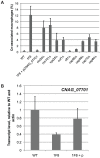Ctr2 links copper homeostasis to polysaccharide capsule formation and phagocytosis inhibition in the human fungal pathogen Cryptococcus neoformans
- PMID: 20824073
- PMCID: PMC2932688
- DOI: 10.1371/journal.pone.0012503
Ctr2 links copper homeostasis to polysaccharide capsule formation and phagocytosis inhibition in the human fungal pathogen Cryptococcus neoformans
Abstract
Cryptococcus neoformans is a human opportunistic fungal pathogen responsible for approximately 1/3 of HIV/AIDS deaths worldwide. This budding yeast expresses a polysaccharide capsule necessary for virulence. Capsule production inhibits phagocytosis by macrophages. Here we describe results that link copper homeostasis to capsule production and the inhibition of phagocytosis. Specifically, using Agrobacterium-mediated insertional mutagenesis, we identified an insertion in the promoter region of the putative copper transporter-encoding gene CTR2 that results in reduced expression of CTR2 and increased phagocytosis by murine RAW264.7 macrophages. The mutant also displayed sensitivity to copper starvation and defects in polysaccharide capsule production and melanization. These defects were all reversed by genetic correction of the promoter insertion by homologous targeting. Several melanization-defective mutants identified previously, those in the RIM20, RIM101, and VPS25 genes, also display sensitivity to copper starvation, reduced capsule production and increased phagocytosis. Together these results indicate a previously undescribed link between copper homeostasis to polysaccharide capsule production and phagocytosis inhibition in Cryptococcus neoformans.
Conflict of interest statement
Figures






References
-
- Park BJ, Wannemuehler KA, Marston BJ, Govender N, Pappas PG, et al. Estimation of the current global burden of cryptococcal meningitis among persons living with HIV/AIDS. AIDS. 2009;23:525–530. - PubMed
-
- Zaragoza O, Taborda CP, Casadevall A. The efficacy of complement-mediated phagocytosis of Cryptococcus neoformans is dependent on the location of C3 in the polysaccharide capsule and involves both direct and indirect C3-mediated interactions. Eur J Immunol. 2003;33:1957–1967. - PubMed
-
- Levitz SM, DiBenedetto DJ. Paradoxical role of capsule in murine bronchoalveolar macrophage-mediated killing of Cryptococcus neoformans. J Immunol. 1989;142:659–665. - PubMed
Publication types
MeSH terms
Substances
LinkOut - more resources
Full Text Sources
Research Materials

